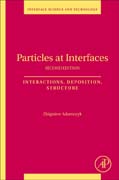
Despite a rapid progress in this area, there is no other book devoted entirely to the subject of particle and protein transport, deposition and structuring at boundary surfaces. Particles at Interfaces: Interactions, Deposition, Structure, Second edition: revised and extended fills this gap by combining traditional theories of electrostatics, hydrodynamics and transport with new approaches based on computer simulations in a cohesive way. In this revised and extended edition the particle and protein adsorption phenomena are unified by presenting the recent developments in this growing field of nanoscience. This is important because the quality of the interpretation of available experimental data does not always match their vast quantity. The role of this book is to provide such information in a simple and appealing way, with emphasis on the understanding of the basic physics behind practical problems. The book includes solved problems of particle transport under non-linear conditions and their relevance to predicting protein adsorption. An entirely new chapter is devoted to polyelectrolyte and protein adsorption at solid/liquid and solid/gas interfaces. The newly emerged fields of biosensor, protein chips, and architectural multilayers of proteins, nanoparticles and polyelectrolytes are also included and discussed. Particles at Interfaces: Interactions, Deposition, Structure, Second edition: revised and extended provides readily accessible theoretical data and recent experimental results and it is a valuable source of information for both students and advanced professionals working in academia and industry. It is self-contained, user-friendly and comprehensive. Most approaches are of a phenomenological nature, enabling one to estimate relevant effects and understand the basic physics of the problem under consideration. This is facilitated because most of the information is well-structured by an extensive use of tables, incorporating schematic drawings and computer-aided artwork. Reviews this topic in a comprehensive and clear wayPresents the information in a user-friendly way including computer aided graphics and schematic drawingsUnifies information from various fields such as electrostatics, hydrodynamic, colloid science, biophysicsApplies a phenomenological approach to the content and provides readily accessible reference data INDICE: 1. Significance of Particle Deposition 2. Potential Interactions among particles 3. Dissipative Interactions 4. Transfer of Particles to Interfaces - Linear Problems 5. Non - Linear Transport of Particles
- ISBN: 978-0-08-101248-2
- Editorial: Elsevier
- Encuadernacion: Rústica
- Páginas: 510
- Fecha Publicación: 01/10/2017
- Nº Volúmenes: 1
- Idioma: Inglés
